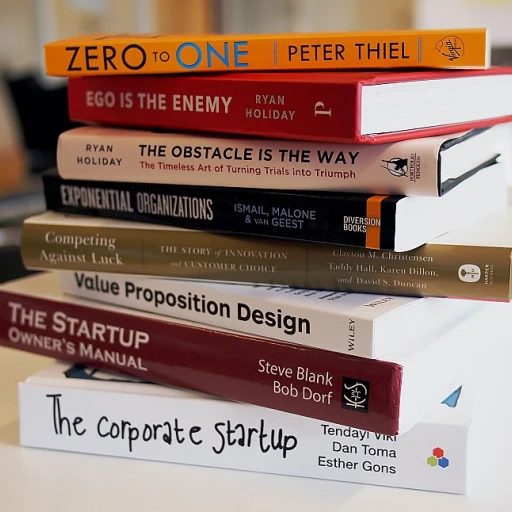
Decoding Open Innovation: Definitions and Distinctions
What Exactly Is Open Innovation?
The concept of 'open innovation' might seem like a buzzword, each hum of its mention resonating with the potential for growth and diversity in ideas. In truth, this multifaceted strategy remains one of the critical drivers of sustainable competitive advantage in the business world. Transforming the approach to innovation, it's a philosophical and practical shift from insular, 'closed innovation' systems that relied solely on internal knowledge and capabilities. Henry Chesbrough, who virtually coined the term at Berkeley, advocates for a more permeable organizational boundary that allows ideas and technologies to flow in and out freely, enhancing creative synergy and accelerating the innovation process.
Open Versus Closed: The Innovation Continuum
On one end of the innovation spectrum, we've got the traditional 'closed innovation' model, where all the magic happens internally, within the four walls of the company. Here, the R&D department is the think tank, the sole birthplace of ideas, technologies, and products making it out to market. Flip the script to 'open innovation,' and suddenly, the external world is an extension of the company's resource pool. Think about it – customers, science communities, even rival companies, can all be part of an organization's extended innovation team. Open innovation leverages external partners and internal efforts to expedite the development of new products and services, creating a dynamic ecosystem of shared knowledge and joint development initiatives.
The New Norm: Why Companies Are Embracing Open Innovation
Driven by both the thrill and necessity of staying ahead, companies are no longer shy about stepping outside the confines of their corporate boundaries. The why is clear: to survive in today's mercurial environment, businesses need to innovate quickly, creatively, and cost-effectively. Rife with examples, big-name players like P&G and LEGO have revolutionized their business models, often taking to heart lessons from the open source software movement - a testament to the idea that 'none of us is as smart as all of us.' So, what's the benefit of hitching a ride on the open innovation bandwagon? Aside from quicker access to a diverse range of innovative ideas and technologies, it also provides an amplified feedback loop with customers and partners, ensuring the innovation reflects actual market needs and technological feasibility.
The Evolution of Open Innovation: From Theory to Practice
Tracing the Roots of Open Innovation
Imagine innovation as a team sport where ideas are the passes and collaboration is the play. Open innovation brings this analogy to life. It embraces the practice of tapping into external sources for ideas, technologies, and knowledge. At its inception, open innovation challenged the traditional, closed model where R&D was tightly controlled within company walls. Henry Chesbrough, a luminary from Berkeley, lit the path with his seminal book on the subject, laying the theoretical groundwork that today's giants like IBM and P&G build upon.
As these creative heavyweights demonstrate, open innovation isn't about giving away secrets; it's about advancing on the shoulders of collective intellect. With this shift, a company transforms from an entity that hoards knowledge to one that thrives on shared intellectual capital. Open innovation signals a shift in power from the company to the collective, a trend increasingly palpable in the tech-enabled business environment of today.
Navigating the Currents of Change
Open innovation's growth trajectory closely mirrors the rise of the internet and global connectivity. No longer are companies restricted by geography; they can connect with partners across the globe. In recent times, start-ups and tech firms have sprinted forward with open innovation initiatives, forging agile, symbiotic relationships to accelerate development. Leveraging the power of external partnerships, businesses grasp competitive advantage and push the boundaries of what's possible.
Statistics tell a compelling story: an insightful report shows that firms utilizing open innovation can enhance their innovation potential by up to 50%. The key is embedding open processes into the overall strategy, ensuring that ideas flow inwards as easily as they flow out. Google, Netflix, and AT&T stand as prime examples, having established open innovation as a cornerstone of their enduring success.
Industry Titans Adopting Open Strategies
Take a look at IBM; their open-source software initiatives have propelled both their growth and the wider tech industry's evolution. Similarly, IBM's commitment to collaborative development has catalyzed a plethora of innovative solutions. Out in space, NASA NASA has harnessed the collective brainpower of the populace, crowdsourcing ideas to tackle complex scientific challenges.
Back on Earth, companies like Lego and GE are showing how involving customers and partners not only accelerates the innovation process but also crafts products that resonate more deeply with market needs. This kind of synergy doesn't just happen; it's a deliberate dance between internal management and external opportunity, painting a vibrant tapestry of collaborative effort.
Integration with Corporate Strategies
But how do you integrate such an open approach without losing the competitive edge? Companies face this innovation challenge by being selective in their open innovation strategies. They manage the flow of ideas and technologies, protecting vital intellectual property rights while still reaping the benefits of external input. The balance is delicate; businesses must navigate the process of open innovation, just like AT&T has, by not only importing external innovations but also outsourcing their surplus ideas, essentially creating a two-way street for innovation traffic.
The movement towards an increasingly open innovation model is not just a phase; it's a profound shake-up of how businesses operate. Adoption is growing, reflecting both the necessity of keeping pace with a fast-moving world and the tangible benefits that a well-implemented open innovation strategy can yield. Companies that once kept their doors closed now see that the walls are coming down, creating a new paradigm where innovation is open, ideas are shared, and the race to innovate draws from the broadest possible pool of ideas and expertise.
Building Bridges: How Companies Forge External Partnerships
Stitching New Patterns in the Business Fabric
It's no secret that the most successful companies don't just sit in their cozy nests, they reach out, create dialogues, and build solid relationships with external partners. This crucial stage of open innovation is akin to stitching new patterns in the business fabric—a process that connects a company's internal strengths with external sources of ideas, technologies, and knowledge. Consider Henry Chesbrough’s definition of open innovation, which emphasizes the importance of utilizing both internal and external ideas to advance technology and markets. Yet, as simple as it sounds, the creation of these external partnerships is an art form with its nuances.
Forging Alliances with Frontier Minds
Let's zero in on one particular approach: engaging with the frontier minds in the startup world. Big-name players like IBM, Google, and General Electric have been scouting tech fairs, hackathons, and incubators for fresh enterprise, connecting with startups that breathe new life into established business models. These alliances often result in dual gains; larger companies imbibe innovative ideas and startups receive mentorship and resources. Take Google for instance, which has acquired over 200 companies, a tactic that feeds directly into its relentless innovation strategy.
Collaborating with Knowledge Hubs
But it isn't just about the startups. Knowledge hubs, such as universities and research institutes in New York, Boston, and Berkeley, are treasure troves for innovative companies. These institutions harbor a culture of investigation and exploration that aligns perfectly with the ethos of open innovation. Partnerships with such entities not only fuel the innovation process but also nurture future talent which is critical for long-term advancement. Philips' collaboration with universities to develop their MRI systems is a testament to the efficacy of tapping into academic knowledge.
Embracing the Customer's Voice
Some may argue that the most impactful external partners are the customers themselves. Procter & Gamble's Connect + Develop program is an exemplary model where customer insights are as valuable as gold, helping to reinvigorate product lines and discover new ones. This symbiosis between company and customer epitomizes a dynamic, outward-facing open innovation process, where feedback loops result in products and services that resonate more deeply with consumer needs.
Creating Synergistic Value
Organizations pursuing open innovation also relish the advent of open-source software and collaborative platforms. These digital alliances provide a fertile ground for co-creation and shared intellectual property, allowing companies such as Netflix and AT&T to develop cutting-edge applications and foster a culture of collaborative community among tech enthusiasts.
In the strategic engine of growth, as detailed in the C-suite Strategy article, external partnerships embody the collaborative spirit, aiding in the seamless integration of fresh insights into existing spheres. It's crucial for businesses to recognize that the value derived from external collaborations can greatly exceed that of solo endeavors.
Navigating Partnership Challenges
Yet, the journey into the realm of external collaborations isn't devoid of hurdles. Trust, or the lack thereof, can impede the flow of ideas, making it essential to establish clear guidelines on intellectual property rights and benefit sharing. Furthermore, aligning different cultures and management styles can be a complex dance, requiring patience and effective communication.
When it comes to building bridges with external partners, businesses often find truths in the challenges open innovation presents: a delicate equilibrium between sharing and protecting, assimilating and individualizing, innovating and yet remaining authentically 'you'.
Balancing Act: Protecting Intellectual Property in an Open Model
Navigating the IP Terrain in Open Innovation
When it comes to open innovation, intellectual property (IP) is often at the heart of complex collaborations. It’s crucial for a company to strike the right balance between sharing and protecting ideas. The open innovation model demands a more nuanced approach to IP management. For instance, Procter & Gamble’s 'Connect + Develop' program hinges on sharing IP to co-create products, but it also ensures proper safeguards are in place to protect the company's assets.
Safeguard Strategies for Collaborative Ventures
Implementing an effective IP strategy calls for several layers of protection. Companies like AT&T and IBM have historically leaned on robust patent portfolios to secure their market positions while engaging in open innovation. These portfolios act as protective moats as they collaborate with startups and science institutions. Furthermore, clear agreements addressing ownership and usage rights are essential when embarking on joint development efforts. Open source software initiatives further exemplify this strategic navigation, where IP is shared under licenses that dictate the terms of use and contribution.
Internal Culture and External Dynamics
An open innovation company must foster an internal culture that acknowledges the value of external ideas and technologies while maintaining a guidepost for IP protection. This culture stems from management's recognition that external knowledge can significantly enhance internal R&D efforts. At the same time, businesses must not overlook the role of customers in shaping the innovation process, as their insights often lead to improvements in products and services.
The Influence of Industry Giants and Groundbreakers
Many industry leaders, such as General Electric and Philips, have showcased how a company can successfully engage in open innovation while keeping a firm grip on IP rights. Through careful strategy and agreements, they have mitigated risks associated with IP exposure. Conversely, Google's acquisition of Motorola Mobility reflected a strategic move to harness IP to defend against competitive pressures. These examples underscore the dual focus on protection and collaboration inherent in this strategy.
Open Innovation Models: Defensive and Offensive Approaches
Henry Chesbrough has often spoken about the need for "open" versus "closed" innovation models. In the context of protecting IP, the open innovation model requires companies to adopt either a defensive or offensive approach to maintain competitive advantage. An offensive approach may involve aggressively seeking IP rights to secure a dominant market position, as seen with players in the tech industry. In contrast, a defensive strategy might emphasize creating a culture of consistent innovation to remain agile and responsive to changes in the market and technology trends.
IP Challenges and Resolutions
Despite the benefits open innovation brings, challenges remain. Sharing ideas with external partners can lead to disputes over IP rights if not carefully managed. Netflix, a proponent of open innovation, manages these challenges by fostering transparent agreements and focusing on mutual gains. Transparency is key, and case studies show that when disputes arise, resolving them quickly and equitably often preserves the value created by the collaboration.
Learning from the Masters: Case Studies in Open Innovation
Dissecting Successful Open Innovation Endeavors
When buzzing about innovation, stories of successful companies provide more than just entertainment. They offer precious nuggets of wisdom about the implementation of open innovation. Take, for example, Procter & Gamble's 'Connect + Develop' platform, which helped the company surge ahead by incorporating external ideas into its portfolio, leading to the realization of over 50% of its product initiatives. A tangible testament to the power of open innovation is their Swiffer collaboration with Japanese company Unicharm, resulting in a blockbuster product that transformed cleaning rituals across the globe.
Another powerful case comes from the world-famous space agency NASA, which embraced open innovation by crowdsourcing ideas to improve the robustness of its systems. Whether collating strategies to optimize the food production process for astronauts or enhancing the algorithms for space navigation, NASA's reliance on external intellect highlights the unlimited potential when tapping into collective knowledge.
Highlighting Industry Trailblazers
How are open innovation strategies shaping big-name businesses? Global conglomerate General Electric (GE) launched its Ecomagination Challenge to call upon entrepreneurs and startups for groundbreaking eco-friendly technologies. The results? Thousands of submissions and millions of dollars invested into developing sustainable technology. This not only benefited GE's portfolio but demonstrated its commitment to corporate social responsibility.
Lego, the Danish toy maker, embraced this strategy by launching its Ideas platform, where the Lego fan community could contribute design proposals, some of which have become wildly popular sets. This business strategy not only fueled their product line but strengthened the bond with their core fans.
Innovating Beyond Borders
Open innovation erases geographical barriers, expanding a company's innovation playground to a global scale. IBM's Innovation Jam brought together employees, families, business partners, and customers from around the world in an epic brainstorming event. By opening the dialogue to diverse perspectives, IBM boosted its innovation capability and translated these insights into successful business ventures.
From AT&T's Foundry innovation centers that accelerate new product development by collaborating with technology startups, to Philips' High Tech Campus in Eindhoven that fosters open innovation among researchers, developers, and entrepreneurs - the tapestry of successful open innovation is rich and varied.
Open Innovation with Precision
Efficient open innovation management often requires a systematic approach to filter and implement external input. Procter & Gamble's approach categorizes external ideas through their development stages, from raw concepts to market-ready products, thereby structuring the chaotic influx of external innovations.
Critical insights from thought leaders like Henry Chesbrough, who coined the term 'open innovation,' and his published works, inform these strategies. His framework has guided numerous companies in devising their open innovation blueprint, underscoring the strategic importance of coupling internal R&D with external innovation sources.
In essence, learning from these case studies in open innovation not only sparks inspiring ideas but also lays down a roadmap for companies aspiring to weave open innovation into their fabric of business operations.
The Client Connection: Involving Customers in the Open Innovation Process
Enriching the Innovation Ecosystem with Customer Insights
Historically, the innovation process might have happened in isolated bubbles, neatly tucked away in R&D departments. But time and again, the collective wisdom confirms: customers are a goldmine of insights. Now, when a business throws open the doors to open innovation, customers step in as valuable players. This internal-versus-external idea exchange is not merely about harvesting suggestions; it's about synergizing lived experiences with scientific and technical strides.
Did you know that upwards of 50% of companies involve customers in their innovation process? It's a vibrant trend, with firms like Lego and Philips setting a high bar. They've demonstrated how harnessing customer feedback can sculpt products and services that truly resonate with the market. This pivot from closed to open, from insular thinking to inclusive strategizing, rewrites the innovation playbook.
The Mechanics of Customer-Driven Innovation
So, how does the cogs turn in this machine? Companies keen on staying ahead are engaging customers at various stages – be it idea generation, product development, or even during the beta testing phases. The benefits? A fresh perspective. Imagine a new set of eyes, detached from company culture and conventional wisdom, scrutinizing your innovation. It's not uncommon to find customers pushing back on overly technical aspects in favor of usability. They add an emotional layer, a practicality filter that sometimes eludes the most proficient of technocrats.
Programs structured to collect and implement customer ideas are making waves. Take General Electric, which leveraged an open innovation challenge to find innovative solutions for its energy projects. Or Netflix, which, despite the legal tangle, showed the might of crowd-sourced innovation through its recommendation algorithm contest. It's a testament to the power of open collaboration, albeit laced with intellectual property right considerations.
Continuous Dialogue: The Open Innovation Lifeline
Sustaining a connection with customers isn’t just about input gathering; it’s an ongoing conversation that feeds the open innovation pipeline. Case in point? Procter & Gamble's 'Connect + Develop' platform showcases a willingness not just to listen, but to enter into a collaborative partnership with customers. The program has been a beacon for innovation open strategies, fueling their product line with a bounty of consumer wisdom.
Yes, there are challenges open innovation must grapple with. Loss of control over proprietary data and the potential over-reliance on external sources of innovation can seem daunting. Yet companies like At&T have shown that with rigorous management and clear boundaries, these challenges can be navigated successfully. The key lies in building a dynamic organization; one that values the process of open innovation and understands the balance between protecting the intellectual property and nurturing an innovative culture.
Championing Co-Creation for Future Innovation
Pioneers like Henry Chesbrough, hailed at Harvard and Berkeley for his groundbreaking work, have long touted the benefits open innovation brings to the table. Co-creation is not just a buzzword, it's the innovation challenge of the modern age: blending ideas, technologies, and knowledge from varied spheres into a cohesive and impactful product slate. When customers are viewed as partners in the journey, rather than spectators, the innovation model transforms into a mutual win, aligning company offerings with real-world needs and desires.
The takeaway here? Tap into the customer base, and you've got a living, breathing innovation lab at your disposal. Not a sterile test environment, but the vibrant beat of society itself.
Measuring Success: Metrics and KPIs for Open Innovation
Grasping the Value of Open Innovation Through Effective Metrics
When it comes to stirring the innovation pot, companies often find themselves at the crossroads of excitement and anxiety. What makes the open innovation model so compelling is not just the influx of fresh ideas, but also the tangible strides a business can make by aligning these initiatives with its core objectives. Measuring the success of open innovation programs is less about tallying the number of brainstorming sessions and more about understanding their impact on the business. Let's fold back the layers and peek into the metrics and key performance indicators (KPIs) that matter.
Surfacing the Right KPIs in a Sea of Data
Navigating through the stormy seas of data can leave businesses waterlogged with information. Cutting through the noise requires surfacing KPIs that are aligned with both business goals and innovation strategies. For instance, a company's innovation heartbeat can be monitored through the rate of idea generation, but the true rhythm is only felt when these are translated into viable products or process improvements.
Engagement KPIs often sail the high seas of priority for businesses fostering innovation. Metrics such as the number of active participants in innovation programs or interactions with external innovation platforms provide a snapshot of the collaborative climate. Additionally, the conversion rate of ideas to projects sparks the curiosity of leaders seeking to undock the potential of their open innovation channels.
Decoding the Impact on Revenue and Efficiency
The proof is always in the pudding—or in the case of open innovation, in the profit margins. An uptick in profits can be a golden indicator of success, highlighting the effectiveness of integrating external inputs into the innovation funnel. Tracking revenue growth from new products or services birthed from open innovation efforts can be a tantalizing treat for the company's stakeholders.
Efficiency metrics also hold their weight in gold. Think reduced time-to-market for new offerings or streamlined internal processes due to open innovation practices. Henry Chesbrough, the groundbreaking thinker behind open innovation, advocates for this seamless blend of ideas and workflows to enhance overall productivity.
Customer-Centric Indicators and Market Position Shifts
In the whirlpool of KPIs, customer satisfaction and market standing emerge as silent but strong currents. Open innovation efforts can be fruitfully measured by the positive feedback loop from end-users and the subsequent buoyancy in the market. A company's ability to keep its ears to the ground and respond to customer needs with brisk innovation is quintessential.
The ripple effect of a company's open innovation initiatives can be mapped through the expansion of market footprint or shifts in brand perception. Keeping a tab on metrics like the Net Promoter Score (NPS) or brand equity post-innovation uncovers the layers of consumer trust and preference molded by innovation endeavors.
Embracing Challenges and Risks Considerately
Open innovation is not an all-sunny voyage; it comes with its share of stormy weather. Metrics that record the encountered challenges—such as increases in intellectual property disputes or cultural misalignments—serve as lighthouses, warning and guiding ships through rough patches.
Understanding the risk-to-opportunity ratio, monitoring the assimilation of external knowledge and technologies within the company's structure, and even recognizing when to retract from certain initiatives can be as critical a measure as any success indicator.
In the end, a company's ability to measure open innovation effectively relies on crafting a balanced scorecard that reflects both the radiant rays of success and the possible perils of partnership. By doing so, open innovation can continue to be an alchemist's stone, turning the base metals of raw ideas into the gold of market-defining products and services.
Adapting to Change: How Companies Stay Ahead with Open Innovation
Embracing Agile Responses to Emerging Trends
To maintain their competitive edge, savvy companies recognize the importance of responsiveness to new trends and shifts in the market. Open innovation provides a platform for integrating external and internal pathways for development, ensuring rapid adaptation and a technological edge. Let’s consider General Electric, which through its open innovation platforms has harnessed collaborative efforts to drive growth in diverse markets, from energy to healthcare.
Integrating Customer Feedback in Real Time
A profound shift occurs when companies treat customers as co-creators. Businesses that have thrived, like Lego, have adopted open innovation practices, leveraging customer input to enhance product development. By doing this, they tap into the vast reservoir of user-generated ideas, many of which have been instrumental in leading to celebrated product lines.
Navigating the Intellectual Property Landscape
In the vein of open innovation, navigating the complex waters of intellectual property (IP) rights can be fraught with challenges. Progressive thinkers such as Henry Chesbrough have long advocated for a nuanced approach to IP, which allows for strategic sharing of technologies while still protecting key assets. Companies are increasingly recognizing that selective collaboration can enhance their innovation capabilities more than rigidly guarding their IP.
Developing a Culture of Continual Learning
Open innovation is not merely a strategy but a mindset that encourages continual learning and evolution. Organizations like IBM exhibit this philosophy by consistently engaging with startups, academic institutions, and other partners to stay at the cutting-edge of technology. This approach cultivates a culture that values knowledge exchange and interdisciplinary collaboration.
Adopting Dynamic Innovation Management Approaches
Leadership within the open innovation company must be adaptable, with a management style that allows for the fluid exchange of ideas. Innovation management bears the responsibility of screening for the most promising ideas and ensuring proper allocation of resources to nurture them to fruition. It’s about striking the delicate balance between open creativity and structured progress.
Case Study: Philips and Innovation Ecosystems
Philips is a stellar example of a company that has created an innovation ecosystem by actively engaging with external sources of knowledge and technology. By blending insights from outside partners with their internal R&D, Philips continues to spearhead advancements in healthcare technology, exemplifying the virtues of a robust open innovation model.
Conclusion
In essence, companies advancing with open innovation embrace change not as a threat but as an opportunity. They recognize that innovation does not happen in isolation and that the judicious integration of external expertise can provide a catalyst for growth and adaptation. The organizations that will thrive are those that balance the fluid incorporation of external ideas with disciplined internal development and strategic IP management, ensuring their place at the forefront of industry innovation.














